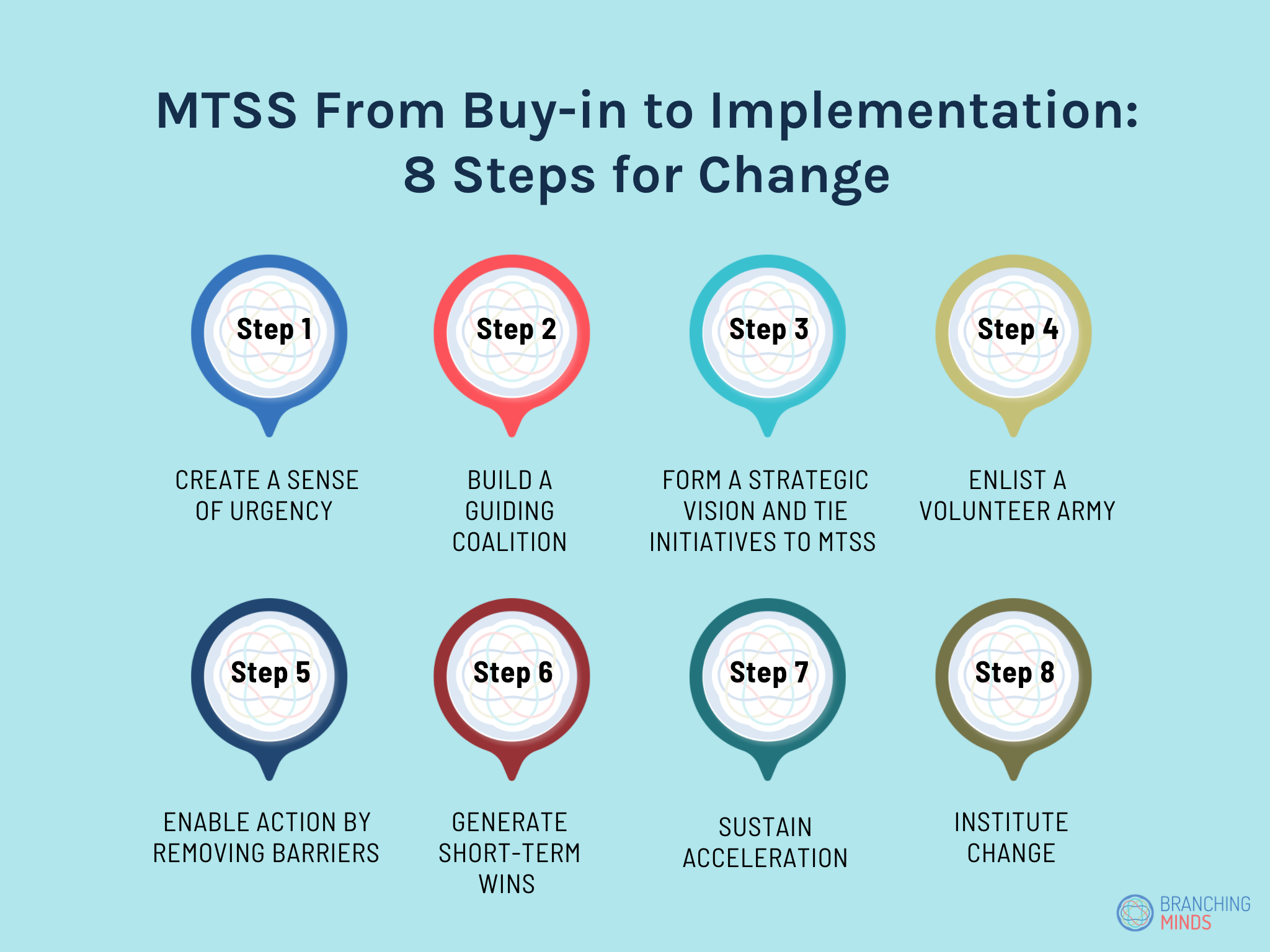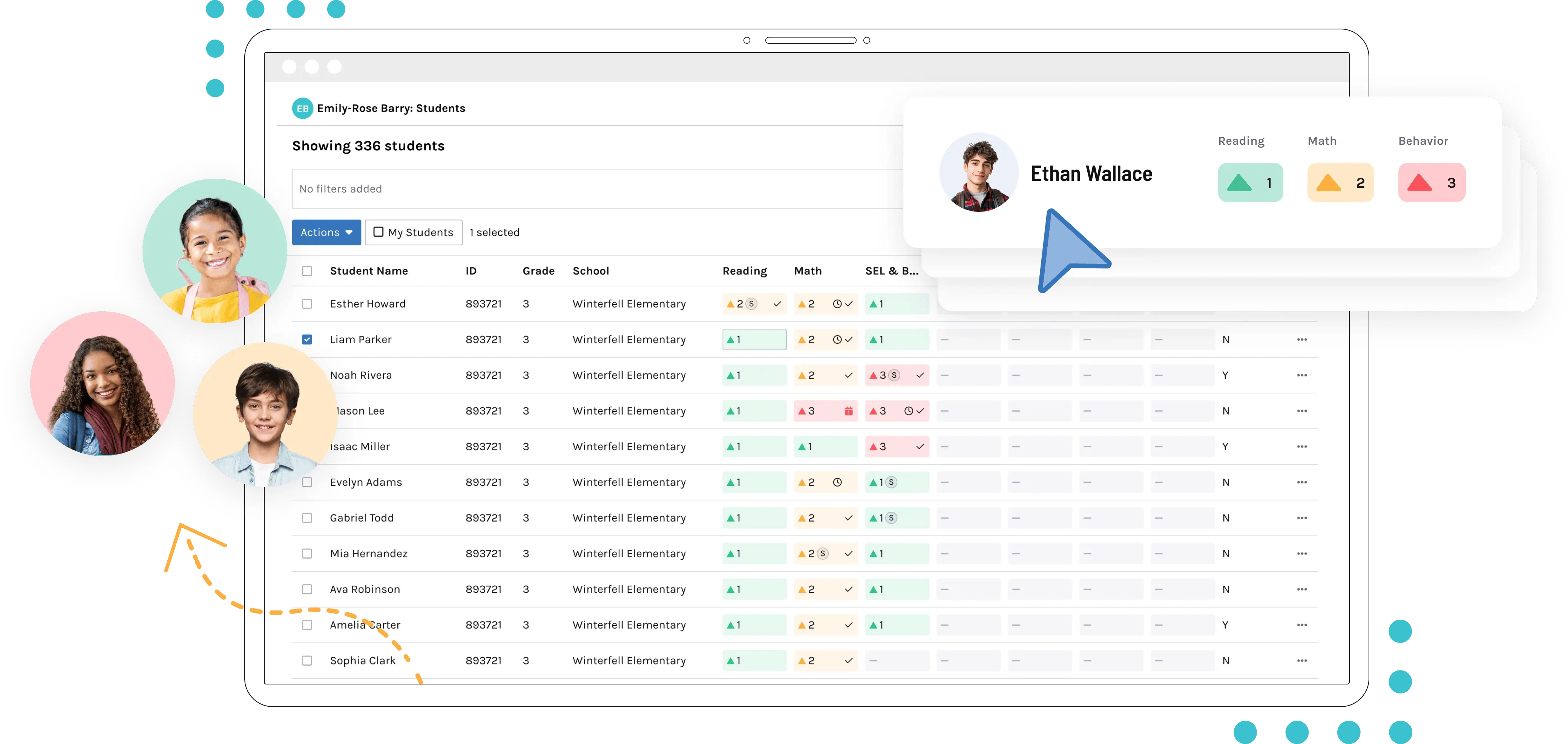As any veteran teacher could tell you, education initiatives come and go with frightening regularity, often not lasting any longer than the time it took to put them in place.
Don't let MTSS implementation suffer the same fate. It's too important for schools to create systems that support the needs of all students. By doing so, you can ensure the vision of MTSS outlasts the many short-lived initiatives that came before it.
MTSS From Buy-In to Implementation: Key Takeaways
- Plan the change. Use a structured process like Kotter’s 8 steps to guide MTSS adoption.
- Build buy-in. Engage leaders and staff to create shared ownership.
- Sustain success. Celebrate wins and embed MTSS into school culture.
Evidence-based change methods and models are here to guide you. These aren't just abstract ideas; they offer a clear, reliable roadmap to help you implement changes effectively, from a "systems-level" view. This means you can step back from individual responsibilities to assess and plan for a comprehensive transformation across an entire school or district. It helps you see the whole forest, not just the trees, making change more manageable and impactful.
The most predominant and well-researched approach is Kotter’s 8-Step Process for Leading Change (Kotter 1996). Here is how Kotter’s process aligns with an MTSS adoption.
Step 1: Create Urgency for MTSS Adoption
In Kotter’s extensive study of organizations and new initiatives, he determined that over 50% of organizations fail at this implementation stage (Kotter 1996). Organizations that lacked a clear vision and failed to demonstrate the need for a new system were unable to maintain motivation for the trajectory of their adopted system. How leadership handles the initial adoption of MTSS sets the tone for the rest of the implementation process.
When introducing MTSS, set a tone of urgency:
- Explain why MTSS is necessary.
- Identify what problems schools are currently facing that MTSS can help with.
- Identify how the current system is failing to address the "red flags" of the education process.
Connect MTSS to your school or district's vision and mission to create immediate buy-in for organized student instruction and intervention. In this early stage, it’s also helpful to provide resources that clearly show the value of MTSS and why adoption is essential.
- Resource: How to Communicate a Vision of MTSS with All Stakeholders to Improve Your MTSS Implementation
Step 2: Build a Guiding Coalition
Once you have decided to institute MTSS, the next step is to create a team to guide the adoption process. Your MTSS team should be representative of your district or campus, with various positions, tenure, and expertise.
The goals of this team are to:
- Anticipate and address potential problems during the MTSS adoption process.
- Lead the implementation phase.
- Identify and prepare data for informed decision-making.
- Communicate with staff and answer specific questions during implementation.
- Analyze options related to MTSS adoption, such as selecting MTSS software.
- Liaise with IT and other departments on data-related issues when choosing an MTSS software.
This team will also organize information on staffing requirements, necessary budget adjustments, and an implementation timeline. Remember, this team is the MTSS leaders, and each member should have a specific role and expertise in the process.
- Webinar: How to Structure MTSS Teams for Better Student Outcomes: Collaboration, Action, and Accountability
Step 3: Form a Strategic Vision and Tie Initiatives to MTSS
From the blueprint set forth by your MTSS team, you can then begin to form a strategic vision that clarifies the goals and expectations of instituting MTSS. Under Kotter’s Method, this vision should be communicable, desirable, have a clear verbal picture, be flexible, feasible, imaginable, and simple.
Your strategic vision should clearly communicate how MTSS will lead to a different future than your district or school’s current reality. Pull from the research and evidence utilized in the first stage when the rationale for MTSS adoption was created.
Your MTSS team should begin by identifying clear initiatives of targeted and coordinated activities that will make the vision a reality. These initiatives are pulled from the strategies and questions analyzed in the previous step, such as specific software adoption or budgeting considerations.
Branching Minds developed The Superintendent's Guide to MTSS and District Strategic Planning to help districts effectively facilitate and align initiatives with their overarching strategies and vision. This comprehensive guide provides resources for building an MTSS handbook, starting with the crucial step of defining your MTSS vision.
Step 4: Engage Your MTSS Champions and Build Buy-In
Once you have created a clear vision and framework for instituting MTSS, the next step is to engage your MTSS champions to move the initiative forward. Kotter’s Method shows that change can only occur when a substantial portion of an organization is brought in to facilitate the process of change adoption. Kotter’s model argues that between 15-50% of a district or school will need to be included at this stage to continue momentum with positive acceptance (Kotter 1996).
This larger group of individuals should include:
- Teachers
- Counselors
- Administrators
- School psychologists
- MTSS coordinators
- Special education professionals
The role of this group is to combat the initiative fatigue of your staff by actively communicating action steps and the rationale for MTSS adoption.
Involving many stakeholders in MTSS adoption ensures consistent, open feedback to your leadership staff. This is crucial as all staff will facilitate the MTSS program. Clearly communicate how MTSS benefits the school, community, and staff—it's not just another teacher task.
If you choose to adopt MTSS software, don’t skip proper training and professional development. The more confident your staff feels, the more likely they will use the software.
Some helpful resources to use at this stage include our article on Communication Planning for MTSS, as well as our turnkey slides for introducing MTSS to your team.

Step 5: Remove Barriers That Slow Implementation
As MTSS adoption moves forward, it’s vital that you identify potential barriers that could be met in the final stages. This includes analyzing how past initiatives have failed, and receiving feedback from your current staff about the current implementation process. It may be helpful to incorporate an anonymous survey for school staff members, so you can target issues before they derail the process.
When considering how past initiatives have failed, it’s important to complete a root cause analysis.
- What is the problem?
- Why did it happen?
- What can be done to prevent it from happening again?
Step 6: Celebrate Early Wins to Keep Momentum
As you navigate the journey of MTSS implementation, one of the most empowering steps is to actively collect, categorize, and share your "wins" with everyone involved.
According to the Kotter Method, a true win is relevant, meaningful, tangible, and replicable – something you can truly build upon.
At this crucial stage, consider expanding your team by bringing more staff into the MTSS process and offering them comprehensive training. This isn't just about sharing the load; it's a fantastic way to keep momentum going strong and ensure everyone feels like a valued stakeholder. When more voices contribute, it validates your continuous feedback loop, which is essential for a thriving implementation.
What kind of "wins" should you celebrate? They don't have to be monumental. Look for those smaller, impactful achievements, like successfully hitting key milestones in staff onboarding, or seeing a wonderful increase in positive satisfaction ratings on your team's feedback forms. Every step forward is a reason to acknowledge your progress and motivate your team.
Step 7: Sustain and Scale MTSS Progress
As you move into the final stages of MTSS implementation, focus on maintaining momentum and supporting your team. Provide the training and professional development staff needed to confidently use your MTSS software.
It’s normal to face some resistance as you expand the rollout. Change can be tough, and staff may feel overwhelmed. The key is consistent communication and a supportive feedback loop.
To ease resistance, keep sharing a clear vision for MTSS. Remind your team of the “why” behind the change. Frame it as a tool for greater efficiency and consistency in supporting students, not as an extra burden. Highlight the positive impact of MTSS, which helps deliver better instruction and interventions, to empower your team, even in the face of the initial workload.
Step 8: Embed MTSS Into Your School Culture
You're almost there! This final stage of the Kotter Method fully embeds MTSS into your school or district. To track progress, ensure teams have clear goals and a detailed rollout schedule. This means supporting school-level MTSS teams and departments tracking student progress.
The goal is to seamlessly weave MTSS into your school's culture. It shouldn't feel like an add-on, but a natural, integrated pathway that supports student success and enhances instructional practices. To ensure MTSS thrives, plan ongoing professional development and effective training for all new staff. This keeps it organic and essential.
As you embrace the Kotter Method for MTSS implementation, remember: every stage is important. It's tempting to rush or combine steps, but Kotter’s research warns that skipping steps often leads to initiatives faltering (Kotter 2012). Taking the time now prevents headaches later!
- Resource: The MTSS Playbook Series
Your Path to MTSS Success
Remember, you don't have to start from scratch! Right from the beginning, your schools and districts can leverage existing staff and resources to evaluate your current system and thoughtfully plan the changes needed to tackle any existing challenges.
By carefully honoring each step of Kotter's Method and fostering an open feedback system throughout this journey, you are paving the way for truly successful MTSS implementation. This creates a stronger, more vibrant school environment that benefits everyone – your dedicated staff, eager students, and the wider community. You've got this!
Additional Resources:
-
Administrator’s Guide to Supporting Teachers with MTSS Implementation
- The MTSS Playbook Series
- How To Avoid 6 Potential Pitfalls of MTSS Pilots & New Implementations
-
The First 100 Days of Multi-Tiered System of Supports (MTSS) Guide
Citations:
Kotter, John P. "Accelerate!" Harvard Business Review 90, no. 11 (November 2012): 45–58.
Kotter, J. P. Leading Change. Boston: Harvard Business School Press, 1996.
About the author
Branching Minds
Branching Minds is a highly respected K-12 services and technology company that leverages the learning sciences and technology to help districts effectively personalize learning through enhancements to their MTSS/RTI practice. Having worked with hundreds of districts across the country, we bring deep expertise in learning sciences, data management and analysis, software design, coaching, and collaboration. Combined with our extensive toolkit of resources, PD, and technology, we provide a system-level solution. We are more than a service or a software provider, we are partners who will deliver sustainable results for educators, and a path to success for every learner.

MTSS Software, Up and Running in Weeks
When districts come focused and aligned, we match that momentum by going live with software set-up timelines that beat nearly every other MTSS management platform.



















.png?width=716&height=522&name=Behavior%20Progress%20Monitoring%20(Preview).png)